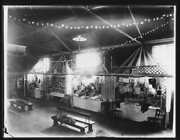 Hartlepool Sports & Leisure
Hartlepool Sports & Leisure
- Cinemas, Theatres & Dance Halls
- Musicians & Bands
- At the Seaside
- Parks & Gardens
- Caravans & Camping
- Sport
 Hartlepool Transport
Hartlepool Transport
- Airfields & Aircraft
- Railways
- Buses & Commercial Vehicles
- Cars & Motorbikes
- The Ferry
- Horse drawn vehicles
 A Potted History Of Hartlepool
A Potted History Of Hartlepool
- Unidentified images
- Sources of information
- Archaeology & Ancient History
- Local Government
- Printed Notices & Papers
- Aerial Photographs
- Events, Visitors & VIPs
 Hartlepool Trade & Industry
Hartlepool Trade & Industry
- Trade Fairs
- Local businesses
- Iron & Steel
- Shops & Shopping
- Fishing industry
- Farming & Rural Landscape
- Pubs, Clubs & Hotels
 Hartlepool Health & Education
Hartlepool Health & Education
- Schools & Colleges
- Hospitals & Workhouses
- Public Health & Utilities
- Ambulance Service
- Police Services
- Fire Services
 Hartlepool People
Hartlepool People
 Hartlepool Places
Hartlepool Places
 Hartlepool at War
Hartlepool at War
 Hartlepool Ships & Shipping
Hartlepool Ships & Shipping

Oxford Street
Details about Oxford Street
Oxford Street
Location
Related items :
 Memories of Wagga
Memories of Wagga
Memories of Wagga.
The Belle Vue Way : 1920s – 1930s by Eric Williams
This is a record of Belle Vue as I knew it as a child and a teenager. It is now losing its identity and I thought it would be a good idea to jot down all that I can remember about the area while passing the time away through these long winter nights when television has little to offer in the way of entertainment.
Starting with Oxford Street, from Baltic Street to St. Aidan’s Church, I’ve always thought how unique that street was for its content and service to the local inhabitants.
At Baltic Street end, looking towards St. Aidan’s , on the left hand corner was the Paragon Works. They made whitening powder for a water-mix to do ceilings, etc., and I believe they packed salt as well, employing girls mainly.
As I write on, I must stress I am open to contradiction if any facts are not strictly correct, it being nearly fifty years ago.
Next to the Paragon Works was a knacker’s yard owned, I think, by someone called Herring. It was a common sight to me seeing a two- wheeled cart pulled by a horse, with a dead horse laid along it, covered with tarpaulins.
On the other corner was a tallow factory owned, I think, by C.W.S., which, at times, emitted an awful, sickening stench. They made candles and I saw some greenish in colour, tied by their wicks in bunches. I vaguely remember that somewhere further along from the knacker’s yard was a black, boarded building with double doors that would accept a flat horse and cart, and a strange sort of character with white hair and a flowing beard, always with a cap, and wearing a dark coat, tied at the waist with rope. I think the horse was white and all I remember on the cart was what looked like a large tank with a brass top and a large funnel – this I understand was for the paraffin the tank contained, for distribution to his customers.
What I think adjoined his premises next door was a blacksmith named Greenhow. Then a back street that was shared with Clarendon Road, with a reputation as far as schoolboys were concerned, of having the best ‘gang’ in Belle Vue! Even having the ‘edge’ on the tough lads in ‘Wagga’ who presided on the southern side of Sydenham Road at the end of Clarendon Road.
Then over the road from Greenhow’s, still in Oxford Street was William Brown’s Sawmill. It seemed to thrive in those days with a regular shrieking of cut timber. I remember a fire there, very spectacular at its peak early on in the morning, because it was the drying shed with stacked timber, and the gable end faced the street. It was throwing out terrific heat, so much so that my family and some others who lived close by in Beechwood Road, next to Clarendon Road, were knocked up by firemen and told to get out of doors for safety. There was a bit of panic, and I had only a coat over my night clothes. Anyway, it passed by without further trouble, except that I contracted colic later that day through a chill on the stomach.
Right opposite to that drying shed was Smith’s the sweet shop. When I was lucky and had a ‘ha’penny’ to spend there was the choice of a bar of chocolate (small), Dolly mixtures, lucky potato that had a shiny charm embedded in the nougat dipped in cocoa, or five toffee caramels to name just a few.
At Christmas there was a large net bag full of seasonal lucky dips, all wrapped in coloured ‘tishy’ paper. In two of them that I remember, one had a coloured tin bird surrounded by a tin ring that spun round a twisted metal stem when forced up with a metal sleeve, giving the impression of being in a pretty cage, and the other had the same mechanism but spun a metal propeller off the end of the stem and into the air which drifted a ‘canny’ way before being grounded.
On the same side as Smith’s, after crossing over Beechwood Road end, was Walburn’s shop, a general dealers, I believe. The woman in there was, to me, very reticent. I think she was a widow and my picture of her was of her being rather solemn with a very pale face, and wearing a ‘mop’ cap, dark, with a crinkly elastic edge, a black, long sleeved cardigan, and a floor length skirt to match.
From there, one comes to the ‘Long Back’. This has gone now, being demolished to put what is now the Belle Vue carriageway in its place. Actually it was Studley Road back street. Studley Road was in three sections, starting from Bourne Road to Russell Street, Russell Street to Oxford Street, and Oxford Street to Sydenham Road. The last section backed on to Beechwood Road, east side, the other two backed on to the timber or ‘prop’ field, still the east side, which adjoined Brown’s Sawmill.
That was the ‘Long Back’. It was well used by the eastern side of Belle Vue residents, night and day. The reason being it was the nearest way to get home if they had been to first or second house pictures, or ‘down town’, where Hartlepudlians did their main shopping along Musgrave Street and round to Lynn Street.
I’m almost sure the nearest public house was the Bourne Hotel, located on South Bourne Terrace and Stockton Road junction. I should imagine that would also be well patronised by Belle Vue dwellers.
The comings and goings of the ‘Long Back’ stick strongly in my memory. There was no lighting, and the enclosure round the prop yard and into Oxford Street towards Brown’s Sawmills had a fence made of railway sleepers, topped with slabwood, making it quite high and very dark at night. Where Russell Street divided the back street was the only relief for some light which was faintly reflected from a gas lamp in Studley Road. In the winter nights lads would ‘dare’ each other to run through it, or go shouting after the drunks who often came staggering home along it. Or play ‘kissing catch’, the procedure being that the girls would get a few seconds’ start running off into the back street and then the boys would chase them. If and when a boy caught a girl he got a kiss and would then leave her and run after another girl. It was a bit of fun and kept your circulation going.
On Guy Fawkes night, and for quite a few nights before that as fireworks were on sale early, lads sometimes ran up the back street throwing ‘bangers’ into the dustbins, which were long square metal boxes covered with wooden doors for pulling out to empty, and ‘bangers’ those days made your ears ring.
Whilst on the subject of bonfire night, over the road from Walburn’s shop on the corner of the ‘Long Back’ was Joe Knowles’ shop. He was a newsagent and later on his son carried on the business. It seemed that after he shut his shop on November 5th, he took all his unsold stock of fireworks over to his house, lit a bonfire in his garden and gave the most spectacular fireworks display you would ever see in Belle Vue. They were mainly the flash bombs – a bang when they went off, and another when they’d rocketed up in the sky with a splash of coloured stars.
There was competition with another newsagent in Oxford Street called Stockdale and his shop was four or five streets further up towards Stockton Street. The ‘paper lads’ would wait outside Knowles at tea time during the week, excluding Sundays, looking out all the time up the back street, watching for the papers that were being brought for them by an older lad who had a bicycle. Having a bicycle then had some prestige, being a luxury. He’d bring the newspapers from the ‘Mail Office’ in a mail bag over his shoulders packed tight, and with the surplus laid on the handlebars he’d pedal as fast as possible under the load all the lads would shout him home and he’d jump off and count the papers in so many dozens as were allocated to each one; and off they would run to their own territory for selling and delivery, hoping to get one over the rival camp.
The ‘Long Back’ was a short cut to the slaughter house, as was Studley Road, to a drover. I don’t know where he brought his small herds of cattle and flocks of sheep from, but it was a common sight once or twice a week to see him coming from Sydenham Road end, carrying a stout stick, with a collie dog in attendance. It was fascinating to me watching them both at work, stopping the odd one or two from straying from the others. One of the drovers was nicknamed ‘The Mad Shepherd’ and I think it was he who caused great distress to myself and some other children. One day, I was told, when for some reason a sheep had panicked and tried to jump the ‘prop’ field fence, then fell and broke its neck, the drover promptly cut its throat, letting the blood run down the back street gutter into a grate.
The next corner to Knowles’ shop was one of four shops on each corner of Studley Road, called Relton’s and it was a general dealer, something like Lipton’s type of shop, where you could buy seed cake, bacon, corned beef, vegetables etc . A popular buy was ‘two penn’orth for the pot – a mixture of turnips, leeks, onions or whatever. You just got ‘pot luck’ on what you received (a good caption) as they just gave you what wasn’t being sold quickly enough. Of course, those were the ‘good old days’! Only if people were working. I’ve always called them the bad old days!
Public Assistance
My father was on public assistance, which was very meagre. Most people couldn’t pay their rates and even the most respectable people were fined and made to pay them weekly. I used to ask the lucky women in my neighbourhood whose menfolk had the rare distinction of being in work, if I could do their messages for shopping, just to get the odd coppers which I spent on something to eat. Sometimes I bought one or two eggs to fry, or a ha’porth of pressed dates, figs or cake from Relton’s.
From Relton’s, still on the east side of Studley Road corner, was the pie-and-pea shop where you went with a dish or anything suitable that would hold the pie and peas with gravy. Prior to that it had been a men’s barber shop: kids called it a ‘tu’penny all off’ simply because you didn’t go till you could afford it, and shame made you go when it grew too long. When you came out, you were the original ‘skinhead’ with a tuft left on the front.
Crossing to the west corner direct was Skinner’s bakery and sweet shop. She was a pleasant woman and made lovely home-made bread and cakes. I’ve never forgotten that smell of home-baked bread on entering the shop at times, and of mouth-watering cakes. She sold only a small quota of sweets. ‘Soda lunches’ I remember well: four small, orangey, round, candy sweets, a short liquorice tube and small packet of ‘kali’ of sherbet, which fizzed in your mouth when sucked through the tube.
One oddment I remember her selling was advertised with a cord in the box, showing an old person in a comic cartoon character, jumping up in the air with fright, knees up, hat flying off, walking stick thrown up, eyes popping, almost suggesting what could be done with these little bomber things. They consisted of two small half-round, stony things, which must have had a toy gunpowder cap in between, with paper twisted round them which, if thrown behind somebody, supposedly cracked behind them. They didn’t appeal to me.
On the fourth corner of Studley Road was Atkinson’s the cobbler’s shop, and it was a noisy one when he was trimming and polishing all the boots and shoes. There were two or three shafts driven by a belt on pulleys, with an assortment of grinding, buffing or polishing wheels. There was a proper shouting match when this was happening and customers wanted attention.
Moving further westward on the same side, past Atkinson’s back street, was the Belle Vue Post Office, only small but it served its purpose. After being served, if you wished, you could pass through it by an adjoining door into Handley’s millinery shop. You could buy clothing, curtains and various miscellaneous items. But to me, the toy window set out for Christmas will always be unforgettable. These toys – donkey boilers, dolls, meccano sets, to name just a few – would be sold mainly to the better-off. I, being one of the poor, could only look longingly at them, but it manifested into a dreamland. I think the worst Christmas was getting just an apple and orange, some nuts and a penny in my stocking, but at the same time, it was appreciated. Although so young, I instinctively knew the score.
Still on Handley’s side, which brought us to South Parade, on the next corner was the fish and chip shop – Stafford’s or somebody’s – and a ‘tu’penny fish and a penn’orth’ was the order of the day. I believe beef dripping was used for frying in those days, giving the food a distinct flavour, in contrast to present day frying. The fat was boiled up with a coal fire which needed regular attention with a small shovel and poker.
Crossing Oxford Street from there, was the other half of South Parade, ending at Sydenham Road. Opposite Handley’s was the chapel and over from the fish shop was a butcher’s shop and a tobacconist and backing them in South Parade was a small dance hall, big enough for a jig for the locals.
Keeping on that same side of Oxford Street you came to a storing place for Dyer’s off-licence right opposite, then you crossed a side street, on the corner of which was the Co-operative Stores, with their own bread and cake shop adjoining them in that same side street, and a butcher’s belonging to them next to the grocery in Oxford Street. When poverty was still rife in my family, I remember going into the Co-op for two ‘penn’orth’ of ‘fat pieces’. These were the shavers off the sides of bacon when they were put in the slicing machine. When you got them home, the leanish pieces were put on one side for sandwiches, and the fatty bits rendered down for dip and bread, which tasted much better than margarine, which tasted like soap to me.
The best margarine was ‘Silver Label’, and every half pound had a silvery band round it. After you had collected so many of them and took them back, you got a free block of bitter chocolate wrapped in blue silver paper, which I thought was very nice to eat.
The butchery next door was where I called once a week for a quarter of pie meat for a family dinner for five, and two ‘penn’orth’ of beef bones to boil and make soup.
The next shop was Freddie Gents, mainly a fruiterer but also selling other odds and ends, and a ‘ha’porth’ of bruised fruit was a regular request from school kids. If you won a race on sports day, I think you got a voucher to spend there for pencil cases and pocket knives, etc., from the Oxford Street school which was situated on the next block.
More detail » Oxford Street 1970
Oxford Street 1970
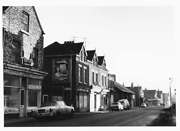 Donated by Douglas Ferriday
Donated by Douglas FerridayPart of the Hartlepool Library Service collection
Picture looking down Oxford Street from Stockton Road. Most of the properties are now empty including the Bakery thought the Turog bread sign is still displayed.
HO4133
More detail » Oxford Street Bakery
Oxford Street Bakery
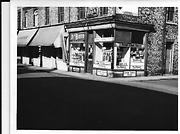 Part of the Library collection
Part of the Library collectionDated 1962
Taken in 1962, the bakery was on the corner of Oxford Street and the street sign says Durham Street. This became Howe Street in 1967. THe familiar Turog bread sign can be seen.
HHT&N 899
More detail » Oxford Street School
Oxford Street School
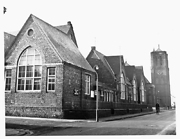 Created by Douglas Ferriday
Donated by Douglas Ferriday
Created by Douglas Ferriday
Donated by Douglas FerridayPart of the Hartlepool Library Collection collection
Dated 1970
Taken from the east end of Oxford Street, the street on the left is Essex Street and the church is St Aidan's
More detail » Oxford Street School 2
Oxford Street School 2
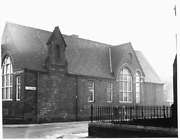 Donated by Douglas Ferriday
Donated by Douglas FerridayPart of the Hartlepool Library Service collection
Picture of Oxford Street school at its junction with Sussex Street.
More detail » Rogers, Confectioner and Tobacconist
Rogers, Confectioner and Tobacconist
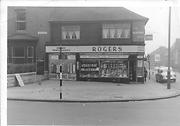 Part of the Library collection
Part of the Library collectionDated 1962
For many years Rogers' Confectioner & Tobacconist's shop was at the corner of Oxford Street and Stockton Road. The shop itself says Oxford Corner. There is a Travel Agency sign in the left hand window of the shop and on the pavement outside is a sign advertising 'Bee Line Excursions'. The Bee Line garage was in Oxford Road almost diagonally opposite the shop. On the right hand side of the photo is Oxford Street School.
This photo was taken in October 1962.
HHT&N 218
More detail » Saint Aidans Church with new spire circa 1912
Saint Aidans Church with new spire circa 1912
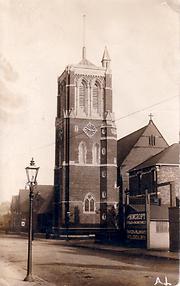 Donated by Norman Bailey
Donated by Norman BaileyDated 1912
Donated by the great, great grandson of Howcroft who, as can be seen on the right of the picture had an engineering company where Tones' Garage is today.
The spire had just been consecrated. Behind the church, Oxford Street School can be seen.
More detail » South Parade and Oxford Street
South Parade and Oxford Street
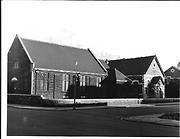 Part of the Library collection
Part of the Library collectionThese chapel buildings are on the corner of South Parade and Oxford Street and were part of the Belle Vue estate most of which was built in the 1870s. South Parade is the only street with the original houses. The chapel on the right is currently derelict but the building on the left, which at the time of the photo was an old people's club, has been converted into a house. The photo was probably taken in the 1970s.
HHT&N 138
More detail » St Aidan's Church
St Aidan's Church
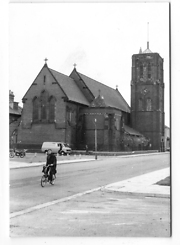 Donated by Hartlepool Museum Service
Donated by Hartlepool Museum ServiceSt Aidans Church, Oxford Street, Hartlepool.
More detail » St Aidan's Church
St Aidan's Church
 Donated by Hartlepool Museum Service
Donated by Hartlepool Museum ServiceSt Aidan's Church, Oxford Street, Hartlepool.
More detail »





